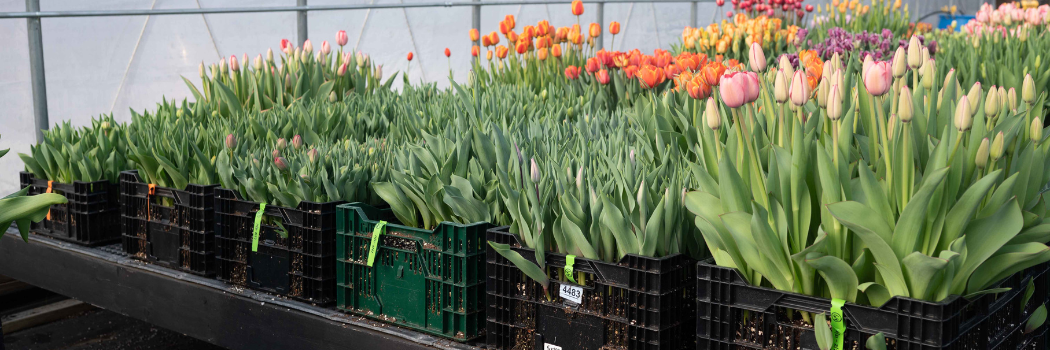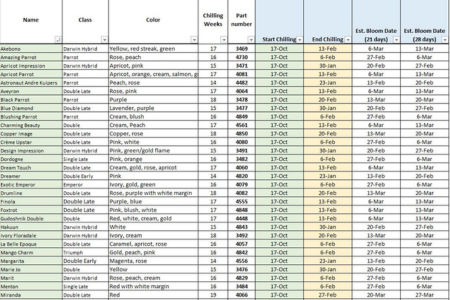- Tulip (Tulipa) Bulb Varieties | Comparison Chart (PDF)
- Tulip (Tulipa spp) | Key Growing Information
- Tulip & Narcissus Production Guide | Tech Sheet (PDF)
- Video: Overwintering Tulips in an Unheated Tunnel
- 'Finola' Double Late Flowering Tulip
- Video: 'Queensday' Tulip | from Johnny's Selected Seeds
- Tulip Harvesting: Tips & Recommendations
- 'Drumline' Double Late Flowering Tulip
- Video: 'Marie Jo' Tulip from Johnny's Selected Seeds
- 'Sensual Touch' Double Late Flowering Tulip
- 'Queen of the Night' Single Late Tulip
- 'Amazing Parrot' Apricot-Colored Parrot Tulip
- 'Dream Touch' Double Late Flowering Tulip
- 'Sunset Tropical' Double Late Flowering Tulip
- 'Astronaut Andre Kuipers' Tulip
- 'Foxtrot' Fragrant Double-Late-Flowering Tulip
- 'Marit' Darwin Hybrid Single Tulip
- 'Charming Beauty' Double Late Flowering Tulip
- 'Parrot King' Tulip
- 'Apricot Parrot' Tulip
- Video: 'Margarita' Tulip from Johnny's Selected Seeds
- Video: Darwin Hybrid Tulips from Johnny's Selected Seeds
- Video: 'Exotic Emperor' Tulip | from Johnny's Selected Seeds
- 'Verona' Double Early Flowering Tulip
- 'Menton' Single Late-Flowering Tulip
- 'Silver Cloud' Triumph Tulip
- 'Black Parrot' Late-Flowering Parrot Tulip
- 'Crème Upstar' Double Late Flowering Tulip
- Cut-Flower Harvesting & Post-Harvest Care | Best Practices from Pros in the Slow Flower Community
- Chrysal Clear Bulb Flower Conditioner | SDS
- Chrysal Clear Bulb T-Bag | Cut-Flower Conditioner | SDS
- Calculator - Bloom Date & Chilling Date for Forced Tulips | Johnny's Selected Seeds
- Introduction to Forcing Flower Bulbs in Soil | Guide to Forcing Flower Bulbs
- 'Mondial' Tulip from Johnny's Selected Seeds
- Forcing Tulip Bulbs | Guide to Forcing Flower Bulbs
- 'Dordogne' Tulip from Johnny's Selected Seeds
- Choosing Tulip Varieties for Forcing | Guide to Forcing Flower Bulbs
- Planting Tulip & Narcissus Bulbs at the Johnny's Research Farm
Forcing Tulip Bulbs
By Joy Longfellow, Flower Trial Technician
Tulips are a popular crop for season extension due to the diversity of varieties, many of which are well-suited for forcing. By providing appropriate conditions, it is possible to have tulips blooming weeks or months before they would be blooming naturally in an outdoor planting.
Johnny's Forced Tulip Trials
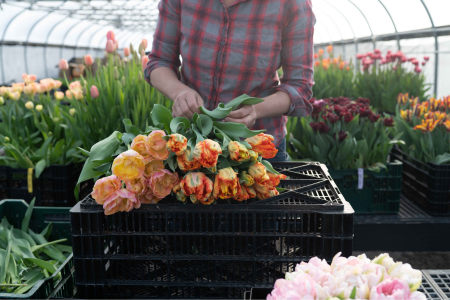
Here at Johnny’s on our Zone 5a research farm, we can extend our tulip season by 4–6 weeks using the methods detailed below (without using pre-chilled bulbs; for more about chilled bulbs, see below ). We are not able to hit Valentine’s Day in Zone 5a, but we are able to have flowers by late February and through the month of March. This allows us to harvest blooms 4–6 weeks before our tulips bloom in unheated tunnels, and 8–10 weeks before our field-planted tulips bloom. Our current tulip season at Johnny’s includes harvests during the following months:
- Forced Tulips: Late February through early April
- Overwintered tunnel tulips: April through early May
- Field Tulips: May
Producing high-quality forced tulips requires some infrastructure and the ability to meet certain temperature and environmental conditions. The information and guidelines presented here represent a starting point for those interested in forcing bulbs. It is possible to push the limits of these recommendations depending on your experience, goals, and available infrastructure. The ideal system for each grower will vary depending on their growing environment, infrastructure, and markets.
Tulip Bulb Forcing Cycle
Like many other spring-flowering bulbs, tulips require appropriate rooting temperatures and chilling temperatures. Without adequate chilling time, tulips will bloom on short stems, making them inadequate for cut-flower production.
Refer to our Introduction to Forcing Flower Bulbs In Soil for general infrastructure and materials required, as well as a conceptual overview of the forcing process.
| Tulip Bulb Forcing Cycle | ||||||
|---|---|---|---|---|---|---|
| Month | Receive Bulbs from Supplier |
Plant Bulbs | Chilling time (including rooting time) |
Greenhouse time | Harvesting | Order for Next Year |
| September | ||||||
| October | ||||||
| November | ||||||
| December | ||||||
| January | ||||||
| February | ||||||
| March | ||||||
| April | ||||||
Understanding and Calculating the Chilling Requirement for Tulips
It is important to make sure that bulbs receive the required number of cold weeks—otherwise blooms and stems may not develop properly. Each variety has its own requirement for chilling weeks, which can generally be found online or from your bulb supplier. Most varieties require between 14–18 weeks of chilling time.
Chilling time consists of two parts: rooting time during which temperatures are maintained at 40–48 °F, followed by the remainder of the chilling time during which temperatures are held at 34°F. The rooting time is considered part of the overall chilling time as long as temperatures don’t rise above 55°F for more than a day or two (International Flower Bulb Centre, 2022).
A note on Pre-Chilled Bulbs: To achieve even earlier harvests, many growers use pre-chilled bulbs. These are bulbs that have already received some or all the chilling weeks required. There are two different standard treatments or preparations for pre-chilled bulbs :
- 9C Bulbs: these bulbs have received some, but not all, of their required chilling weeks. They will need a rooting period as well as additional chilling time once you receive them.
- 5C Bulbs: these bulbs have received all their required chilling time and will need only a rooting period before being moved to a greenhouse for growing on.
- Johnny’s does not currently offer any pre-chilled bulbs. All trial results and dates to flower are from uncooled bulbs that received their entire chilling requirement on-site at our research farm.
| Timeline of Field-Grown vs. Forced Tulip Bulbs | ||||
|---|---|---|---|---|
| Month | Field-Grown | Forced | ||
| September | Planting | Planting | ||
| October | Planting | Planting | Chilling | |
| November | Rooting & Chilling in the Ground | Planting | Chilling | December | Rooting & Chilling in the Ground | Chilling |
| January | Rooting & Chilling in the Ground | Housing | Chilling | |
| February | Rooting & Chilling in the Ground | Housing | Chilling | Flowering |
| March | Rooting & Chilling in the Ground | Housing | Flowering | |
| April | Emergence | Flowering | ||
| May | Flowering | |||
How to Force Tulip Bulbs: A Step-by-Step Process
Planting
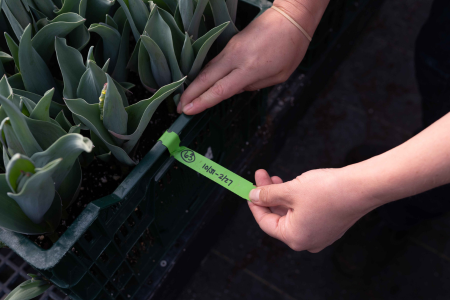
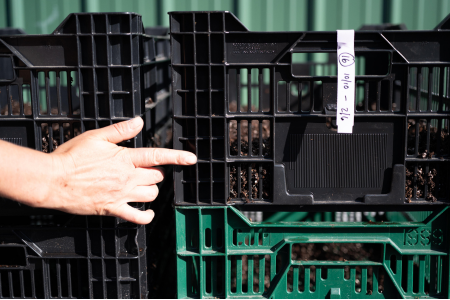
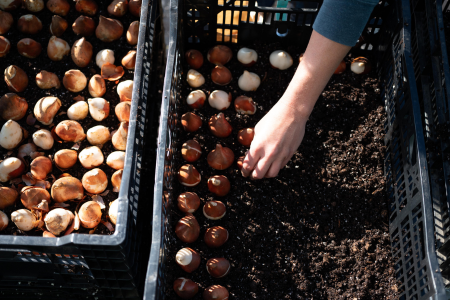
Receive bulbs from supplier. The forcing process can start immediately upon receiving bulbs. The sooner you start the forcing process, the earlier you will have flowers.
If not planting immediately upon receiving, store bulbs in cool, dry conditions until you are ready to plant. Depending on your desired harvest window and the varieties you choose to force, you may be planting bulbs in crates on a weekly basis for several weeks.
-
Label crates. We find it helpful to use Fastlock labels to mark date in, date out, and variety. We use different colored labels to correspond to the week the crate is removed from the CoolBot® (i.e. all crates with green labels come out week 7; all crates with pink labels are removed week 8, etc.).
-
Fill crates with 2–3” of well-moistened soil or potting media. We use Pro-Mix as it is a sterile, soilless medium.
A single layer of newspaper in the base of the crate can help minimize soil loss but is not necessary. Lining the crate with heavy, less permeable materials like cardboard or plastic is not recommended, as this can inhibit root development.
- Place bulbs in crates, almost touching, like eggs in an egg carton. Depending on the size of the bulbs, 60–70 bulbs will usually fit comfortably in a crate. It’s also ok if bulbs are lightly touching each other.
Cover the bulbs with an additional 3 inches of soil. The tops of the bulbs should not be visible under the soil.
Water in heavily. The soil should be saturated at this point. This will help weigh down the bulbs.
If the bulbs are not sufficiently covered and weighted down, they may heave out of the soil as roots develop. During the rooting time bulbs can generate a tremendous network of roots and the energy and force of those roots can propel the bulb up out of the soil. A heavy, wet layer of soil can help avoid this problem.
Some growers place a layer of wet sand on top of their bulbs or mix sand into the potting medium to add more weight. We have added sand to the top of our crates in previous years but find it challenging to 1) keep the sand wet enough upon removal from cold storage and 2) keep the sand in the crates. We have found a 3-inch layer of well-saturated potting mix provides sufficient weight to prevent heaving of bulbs.
Chilling or Cold Period
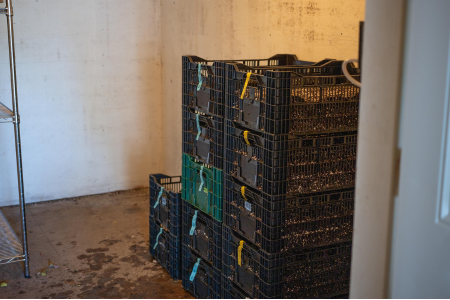
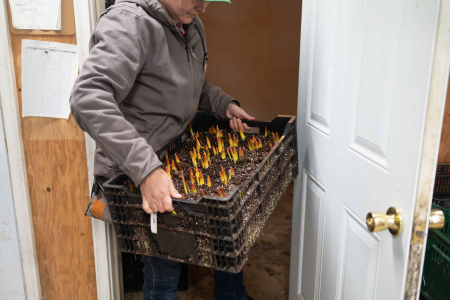
-
Move well-watered crates to their rooting and/or chilling space. Crates can be stacked on top of each other during the rooting and chilling time. Stacks of crates should have 1–2 inches of space between them to allow for airflow.
Because of air movement within the chilling space, crates on the tops of the stacks may dry out sooner than crates at the bottom. Monitor crates at the top of the stacks during the winter for dry soil. Add water if you observe crates drying out.
-
Rooting time: the crates should be stored for 2–3 weeks at 40–48°F in a dark environment, so that roots can develop. You should observe roots beginning to extend out of the sides of the crates towards the end of this period.
- Keep bulbs dark. Light will initiate shoot development.
- Keep bulbs protected from mice/voles.
- If crates appear to be drying out, provide more water.
- Keeping relative humidity high (90–95%) will help retain moisture in the crates.
Transition to 34°F for remainder of chilling time. The total chilling requirement for a variety is inclusive of the rooting time. For example, if a variety requires 16 weeks of chilling and it spent 2 weeks in rooting time, it requires 14 more weeks of chilling time at 34°F.
- After root development is visible, either drop temperatures to 34°F or move crates to a cold environment (34°F) for the remainder of their required cold period.
- Different varieties will develop roots at different rates. It’s more important to just provide a general rooting time (cool, dark, wet) than that every crate/every variety have the same amount of root growth before dropping the temperature to 34°F.
- Keep as close to freezing as possible. There is some flexibility here and bulbs will tolerate some deviation from these temperatures; however, you don’t want the bulbs to freeze, and you also don’t want them to get too warm, as this may compromise their chilling time or promote excessive shoot growth before the end of the chilling time.
Forcing
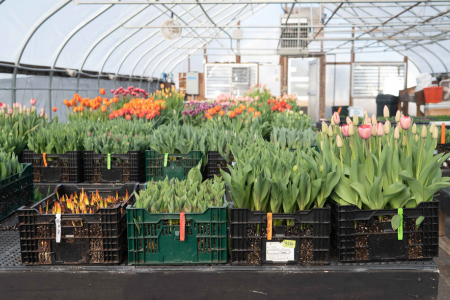
Once bulbs have received their requisite cold weeks, remove them from cold storage and bring into a warm, light space. A heated greenhouse is ideal. During this period (called housing), pay attention to the following environmental variables:
- Light: natural daylength in a greenhouse environment should provide sufficient light for tulip forcing.
- Heat: Ideally temperatures will be 58–65°F for forcing (International Flower Bulb Centre, 2022).
- Cooler temperatures will slow plant development. If grown too cool, flowering can be delayed, plants may suffer developmental problems, and bloom quality and stem length can be compromised.
- Warmer temperatures will hasten plant development and tulips will likely bloom earlier. If temperatures are too high, some varieties may elongate too quickly and bloom on long, thin stems while other varieties may bloom too fast on very short stems.
- Water: water bulbs in heavily after removing from the CoolBot. Bulbs will not have had any water in several months. Make sure water is getting down to the base of the crate where the roots are. Keep crates well-watered during the entire forcing time. Soil in the crates should be near saturated as the bulbs are growing and should not dry out. Hand watering can be time-consuming and once buds start to form and plants develop, can create damage to blooms by overhead watering. Drip irrigation is ideal.
- Fertilizer: no additional fertility is needed. Bulbs should have sufficient resources to produce a flower without added fertility.
- Ventilation: at Johnny’s we ventilate during the day to provide as consistent a temperature as possible and to manage humidity.
Harvesting
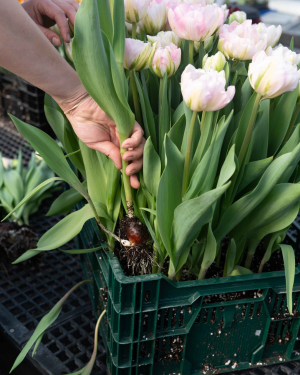
Generally, a variety grown in a space heated to 60°F will flower in 4 weeks after removal from cold storage. Time to flower can vary greatly by variety, seasonal weather conditions and forcing environment. Cool, cloudy days will slow bloom development, while hot sunny days will warm the greenhouse and hasten flower maturity.
- Harvest tulips as you would normally from a field or in-ground planting. If you are planning to store for a long period, tulips can be harvested with the bulb on and stored dry.
- Compost bulbs and soil.
- Wash and sterilize crates before re-use. This is important to prevent diseases such as Rhizoctonia and Pythium.
- Record bloom dates and variety performance. Some varieties will perform better when forced earlier in the season compared to later in the season. Since there is a great deal of variability in variety performance between varieties and across the forcing season, taking detailed notes on preferred varieties and gaps in bloom times during your season will help you plan for next year.
- Order early for next season. Popular varieties sell out fast. Order as early as possible.
Common Problems & Their Causes
Diagnosing forcing issues can be complicated. While bulbs can tolerate some deviation from recommended conditions, too much variation at any point in the bulb life cycle can affect bloom and stem quality. It can sometimes be difficult to pinpoint the exact cause of a problem, as things such as flower quality can be affected by conditions at many points throughout the bulb life cycle. Diagnosing problems also has a seasonal component. You may see different issues in varieties forced in the late winter and early spring compared to varieties forced later in the spring. Here are some common problems and possible causes.
- Heaving Bulbs; Overly Vigorous Root Growth
- Striking the balance for appropriate root growth can be challenging. If roots grow too vigorously, they can cause “heaving” of the bulbs, pushing bulbs out of the soil. A very dense mat of roots can also be more susceptible to Trichoderma infection. Alternately, if the root system is underdeveloped or insufficient when plants are brought into the greenhouse for forcing, the bulb may expend energy developing roots and shoots at the same time.
- In general, warmer temperatures promote root development (40–48°F) while cooler temperatures slow root development. If root growth is excessive, or bulbs are heaving out of the soil, dropping the temperature closer to 32°F will slow development.
- Early or Overly Vigorous Shoot Growth
- During the chilling period you will likely see shoots emerge from the soil. Ideally these shoots remain 1–2” tall and do not grow above the edges of the crates.
- In general, warmer temperatures also promote shoot development. If you see shoots developing too quickly, dropping the temperature of your chilling room will help slow development of shoots.
- Once the chilling temperature is dropped after the rooting period, do not raise it. Raising the temperature in the chilling room before housing can trigger shoot growth.
- Stems too short
- Cultivar selection: some varieties are not well-suited for forcing, or are best suited for different seasonal slots.
- Insufficient chilling time: the chilling time allows for stem development in the tulip and is required for optimal stem length. Chilling at cooler temperatures (35F–38°F) is generally recommended for cut flower tulips as these temperatures produce longer stems. If producing tulips for pot production, warmer temperatures are often used (45–48°F) as these conditions will produce slightly shorter stems (Miller, 2010).
- Insufficient moisture: if plants do not have sufficient moisture to support growth in the greenhouse period, plants may be stunted.
- Stems too long
- Cultivar selection: varieties that are tall and leggy in the field will be more likely to be tall/leggy in a forcing environment.
- Excessive cooling: if bulbs receive more chilling weeks than recommended, some cultivars can stretch quickly and produce tall, weak stems. This problem is more common with later-season forcing, where plants are likely to have had longer chilling times and to have been exposed to higher temperatures.
- Flower abortion
- The failure of the plant to produce a marketable flower can be caused by several different environmental factors throughout the lifetime of the bulb (Hertogh,1996). If you see flower abortion in your crop, here are some possible causes:
- Temperatures too high: during transport, dry storage before planting, or in the greenhouse during forcing.
- Ethylene exposure: Tulips are very sensitive to ethylene so exposure of bulbs or plants to ethylene gas from fruits or other flowers, or from other sources could affect flower development.
- Insufficient water: if the bulbs dry out either during chilling or forcing, flower abortion may occur.
- Insufficiently developed root systems.
- Inadequate ventilation.
- The failure of the plant to produce a marketable flower can be caused by several different environmental factors throughout the lifetime of the bulb (Hertogh,1996). If you see flower abortion in your crop, here are some possible causes:
- Stem Topple
- This disorder occurs when developing plants cannot access sufficient calcium. The lack of calcium leads to weak necks or stems, and blooms may snap or break just below the bloom (Hertogh, 1996). Some possible causes include:
- Cultivar selection: some varieties are prone to this disorder
- Excessive cold weeks: if bulbs receive a longer chilling period than recommended, plants tend to grow rapidly once placed in the forcing environment. The plant may not be able to supply sufficient calcium to the rapidly growing stem and weakness can occur.
- High greenhouse temperatures (above 68°F): these conditions also cause rapid plant growth and can outpace the plant’s ability to move calcium up the stem.
- Calcium moves through the plant via transpiration, so making sure transpiration is possible will also help. Keeping greenhouses well-ventilated and not allowing relative humidity to be too high will support transpiration.
- This disorder occurs when developing plants cannot access sufficient calcium. The lack of calcium leads to weak necks or stems, and blooms may snap or break just below the bloom (Hertogh, 1996). Some possible causes include:
Next up: read Choosing Tulip Varieties for Forcing to learn about variety selection and succession planting strategies.
References
- Hertogh, A. D. (1996). Holland Bulb Forcer's Guide. Hillegom, The Netherlands: The International Flower Bulb Centre.
- International Flower Bulb Centre. (2022). The Forcing of Tulips: Forcing methods for cut flower production and for pot plant production.
- Miller, D. W. (2010, November). A Review of Procedures for Forcing High Quality Rooting Room Bulbs. Retrieved from Research Newsletter: http://hort.cornell.edu/bulb/newsletter/pdfs/25-201011.pdf


